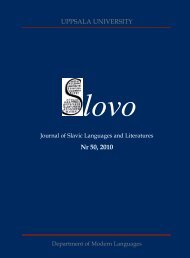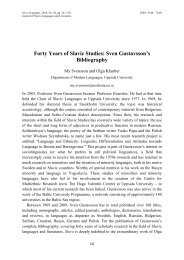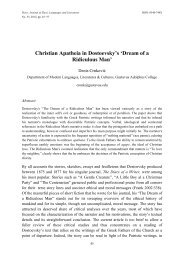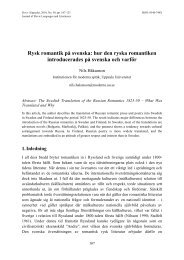Slovo (<strong>Uppsala</strong>), 2010, No. 51Journal <strong>of</strong> Slavic Languages and Literaturesaddition, the project organisation includes a reference group <strong>of</strong> nine specialists: UllaBirgegård (<strong>Uppsala</strong> University, em.), Per-Arne Bodin (Stockholm University), RalphCleminson (University <strong>of</strong> Portsmouth), Elisabeth Löfstrand (Stockholm University),Ingrid Maier (<strong>Uppsala</strong> University), Anisava Miltenova (Bulgarian Academy <strong>of</strong>Sciences), Lars Steensland (Lund University, em.), Mirja Varpio (Lund University,em.), and Hans Åkerström (Gothenburg University Library, em.).The DSS project continues research conducted in Swedish repositories by severalgenerations <strong>of</strong> slavists, and without the accomplishments <strong>of</strong> our predecessors, Swedishand foreign colleagues, the work within the project would simply not be possible.During the first year <strong>of</strong> the project period almost fifty Swedish repositories havebeen investigated. Of these, approximately thirty (see Appendix, below) containCyrillic and Glagolitic materials <strong>of</strong> relevance to the project. In addition to alreadyknown manuscripts and printed books, the material also includes several previouslyunknown books and fragments. A preliminary inventory <strong>of</strong> the presently knownmanuscripts and printed books (Granberg et al. 2010) was published as the first reportin the series Cyrillica Suecana (see https://gupea.ub.gu.se/handle/2077/23786).Another part <strong>of</strong> the work during the first year <strong>of</strong> the project has focused on thestructure <strong>of</strong> the descriptions <strong>of</strong> the materials. Two different models have beenestablished: one for the description <strong>of</strong> manuscripts and another for the description <strong>of</strong>early printed books, and several preliminary descriptions <strong>of</strong> different types <strong>of</strong> books(manuscripts, Slavonic printed books, books printed in “civil print”) have beencompleted. These descriptions will be presented and discussed at a workshop inStockholm in January 2011, organized in cooperation with the research department <strong>of</strong>the National Library <strong>of</strong> Sweden (Kungliga biblioteket).In early 2010 a database (SVEKYR) was created in order to facilitate cooperationwithin the project. Eventually, the database will contain records <strong>of</strong> all manuscripts andcopies <strong>of</strong> printed books that will be described within the project. The description willinclude all records <strong>of</strong> early Cyrillic manuscripts and early printed books in Swedenlisted in existing catalogues (Roubetz s.a., Glubokovskij 1918, 1919, Kjellberg 1951[with the handwritten additions in the copy located at <strong>Uppsala</strong> University Library],Gawryś & Jansson 1956, Gawryś 1960, 1961, Davidsson 1975, Steensland 2005, etc.),relevant records in the electronic Swedish Union Catalogue <strong>of</strong> printed books(LIBRIS), etc., as well as records <strong>of</strong> previously unknown manuscripts and printedbooks. At present (December 2010) the SVEKYR database comprises approximately athousand records (ca. 200 manuscripts and ca. 800 copies <strong>of</strong> printed books). Thedatabase is designed primarily as a working tool for the project, and in addition t<strong>of</strong>ields describing the actual materials (author, title, time <strong>of</strong> origin, place <strong>of</strong> origin, etc.),all records also include fields pertaining to the work by the project participants(references to related archival materials and notes, dates <strong>of</strong> inspection de visu, etc.).Some <strong>of</strong> the descriptive fields are designed and numbered with reference to the108
P. Ambrosiani, A. GranbergSlavonica Glagolitica and Cyrillica in Swedish Repositories…MARC21 standard that is used in LIBRIS and many other electronic catalogues.Notwithstanding the obvious limitations <strong>of</strong> MARC21 for descriptions <strong>of</strong> manuscriptsand early books, it is important for the DSS descriptions to be organized in a way thatwill make them usable for improving the existing records <strong>of</strong> many <strong>of</strong> the early Cyrillicprinted books in LIBRIS (and possibly also in other electronic catalogues).The DSS project aims to present a fuller picture <strong>of</strong> the early Cyrillic and Glagoliticmaterials in Sweden than the existing catalogues. When it comes to the presentationand description <strong>of</strong> the early printed books, some <strong>of</strong> the differences between the mostimportant earlier catalogue, Lennart Kjellberg’s Catalogue des imprimés slavons desXVIe, XVIIe et XVIIIe siècles conservés à la Bibliothèque de l’Université royaled’<strong>Uppsala</strong> (Kjellberg 1951), and the DSS approach can be described as follows (thereare, <strong>of</strong> course, also many similarities: for example, both include Cyrillic as well asGlagolitic books, and both concentrate on books printed during the 16th–18thcenturies):1. The basic unit in Kjellberg 1951 is the copy, whereas in the DSS project it isthe edition. Without going into a detailed discussion on which type <strong>of</strong>information refers to the edition, and which to the investigated copy, DSS,following Nemirovskij 1996, 2009, Cleminson et al. 2000, and othercatalogues, prefers a hierarchical presentation, with a clear distinction betweenedition and copy.2. Kjellberg 1951 excludes books printed in the civil script introduced in Russia in1708 (graždanskij šrift) and only lists Cyrillic books printed in a ChurchSlavonic typeface (staropečatnye knigi). The DSS project, on the other hand,will also describe 18th-century books printed in civil script, including bookswith mixed Cyrillic civil and Latin (Gothic) script, such as bilingual grammars.3. In Kjellberg 1951, Cyrillic and Glagolitic books are listed in a single numberedinventory, whereas DSS separates different types <strong>of</strong> materials in differentsections (A. Manuscripts; B. Early printed books, Slavonic Cyrillic; C. Earlyprinted books, Glagolitic; D. Early printed books, civil print; etc.)4. The original edition <strong>of</strong> Kjellberg 1951 included only copies located at <strong>Uppsala</strong>University Library, but the handwritten additions also list books located atseveral other Swedish repositories (Linköping City Library, Lund UniversityLibrary, the Royal Library in Stockholm, the Västerås Diocesan and CountyLibrary, the Rogge Library in Strängnäs, etc.). The ambition <strong>of</strong> the DSS projectis to cover all the main public repositories, and a few private ones, in Sweden.109
- Page 1 and 2:
UPPSALA UNIVERSITYlovoJournal of Sl
- Page 3:
CONTENTSEDITORIAL: SLOVO ARAUND THE
- Page 6 and 7:
Slovo (Uppsala), 2010, No. 51Journa
- Page 8 and 9:
Slovo (Uppsala), 2010, No. 51Journa
- Page 10 and 11:
Slovo (Uppsala), 2010, No. 51Journa
- Page 12 and 13:
Slovo (Uppsala), 2010, No. 51Journa
- Page 14 and 15:
Slovo (Uppsala), 2010, No. 51Journa
- Page 16 and 17:
Slovo (Uppsala), 2010, No. 51Journa
- Page 18 and 19:
Slovo (Uppsala), 2010, No. 51Journa
- Page 20 and 21:
Slovo (Uppsala), 2010, No. 51Journa
- Page 22 and 23:
Slovo (Uppsala), 2010, No. 51Journa
- Page 24 and 25:
Slovo (Uppsala), 2010, No. 51Journa
- Page 26 and 27:
Slovo (Uppsala), 2010, No. 51Journa
- Page 29 and 30:
Alexander I. Pereswetoff-MorathIsaa
- Page 31 and 32:
Alexander I. Pereswetoff-MorathIsaa
- Page 33 and 34:
Alexander I. Pereswetoff-MorathIsaa
- Page 35 and 36:
Slovo (Uppsala), 2010, No. 51, pp.
- Page 37 and 38:
Juhani NuorluotoIzvori za prouĉava
- Page 39 and 40:
Juhani NuorluotoIzvori za prouĉava
- Page 41 and 42:
Juhani NuorluotoIzvori za prouĉava
- Page 43 and 44:
Juhani NuorluotoIzvori za prouĉava
- Page 45 and 46:
Juhani NuorluotoIzvori za prouĉava
- Page 47 and 48:
Juhani NuorluotoIzvori za prouĉava
- Page 49 and 50:
Juhani NuorluotoIzvori za prouĉava
- Page 51 and 52:
Juhani NuorluotoIzvori za prouĉava
- Page 53:
Juhani NuorluotoIzvori za prouĉava
- Page 56 and 57:
Slovo (Uppsala), 2010, No. 51Journa
- Page 58 and 59:
Slovo (Uppsala), 2010, No. 51Journa
- Page 60 and 61: Slovo (Uppsala), 2010, No. 51Journa
- Page 62 and 63: Slovo (Uppsala), 2010, No. 51Journa
- Page 64 and 65: Slovo (Uppsala), 2010, No. 51Journa
- Page 66 and 67: Slovo (Uppsala), 2010, No. 51Journa
- Page 68 and 69: Slovo (Uppsala), 2010, No. 51Journa
- Page 71 and 72: Slovo (Uppsala), 2010, No. 51, pp.
- Page 73 and 74: Никита МихайловО м
- Page 75 and 76: Никита МихайловО м
- Page 77 and 78: Никита МихайловО м
- Page 79 and 80: Никита МихайловО м
- Page 81 and 82: Никита МихайловО м
- Page 83: Никита МихайловО м
- Page 86 and 87: Slovo (Uppsala), 2010, No. 51Journa
- Page 88 and 89: Slovo (Uppsala), 2010, No. 51Journa
- Page 90 and 91: Slovo (Uppsala), 2010, No. 51Journa
- Page 92 and 93: Slovo (Uppsala), 2010, No. 51Journa
- Page 94 and 95: Slovo (Uppsala), 2010, No. 51Journa
- Page 97 and 98: Slovo (Uppsala), 2010, No. 51, pp.
- Page 99 and 100: Карине Окерман Сар
- Page 101 and 102: Карине Окерман Сар
- Page 103 and 104: Карине Окерман Сар
- Page 105 and 106: Карине Окерман Сар
- Page 107 and 108: Карине Окерман Сар
- Page 109: Slovo (Uppsala), 2010, No. 51, pp.
- Page 113 and 114: P. Ambrosiani, A. GranbergSlavonica
- Page 115: Stockholm, The Strindberg Museum (S
- Page 118 and 119: Slovo (Uppsala), 2010, No. 51Journa
- Page 120 and 121: Slovo (Uppsala), 2010, No. 51Journa
- Page 122 and 123: Slovo (Uppsala), 2010, No. 51Journa
- Page 124 and 125: Slovo (Uppsala), 2010, No. 51Journa
- Page 126 and 127: Slovo (Uppsala), 2010, No. 51Journa
- Page 128 and 129: Slovo (Uppsala), 2010, No. 51Journa
- Page 131 and 132: Slovo (Uppsala), 2010, No. 51, pp.
- Page 133 and 134: Мария ЭнгстремАпоф
- Page 135 and 136: Мария ЭнгстремАпоф
- Page 137 and 138: Мария ЭнгстремАпоф
- Page 139 and 140: Мария ЭнгстремАпоф
- Page 141 and 142: Мария ЭнгстремАпоф
- Page 143 and 144: Slovo (Uppsala), 2010, No. 51, pp.
- Page 145 and 146: Ingrid MaierRecension: Tore Nesset:
- Page 147 and 148: Ingrid MaierRecension: Tore Nesset:
- Page 149 and 150: Ingrid MaierRecension: Tore Nesset:
- Page 151: Slovo (Uppsala), 2010, No. 51, pp.












